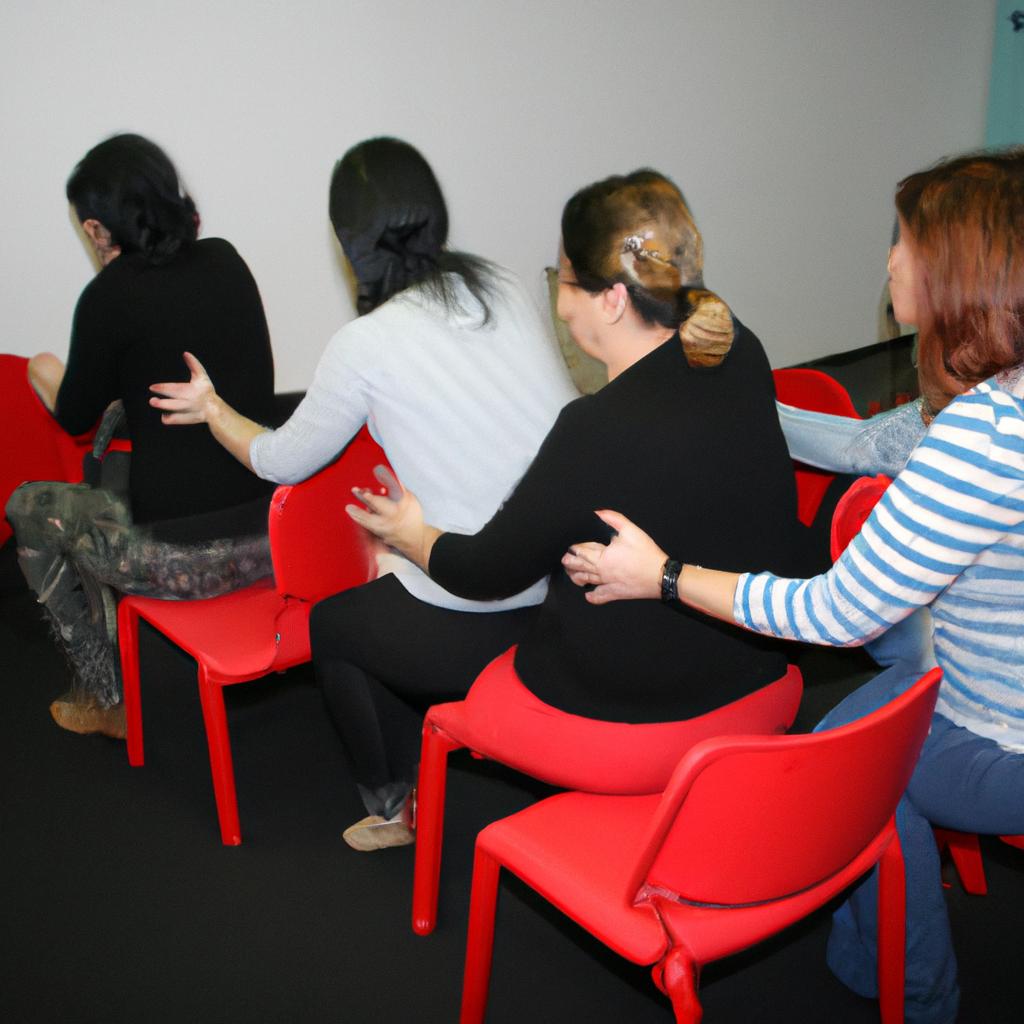Family therapy is a collaborative treatment approach that aims to promote mental health by involving the entire family system in the therapeutic process. This article explores the effectiveness of family therapy as an intervention for individuals experiencing mental health challenges, emphasizing its potential benefits over individual-focused approaches. By examining a hypothetical case study of a teenager struggling with depression and anxiety, this article highlights how family therapy can address not only the individual’s psychological distress but also improve overall family dynamics.
In recent years, there has been growing recognition that an individual’s mental health is intricately connected to their familial environment. Family therapy recognizes the importance of understanding and working with these interconnected relationships within families to achieve positive outcomes. For instance, consider a hypothetical case where a 16-year-old named Sarah presents with symptoms of depression and anxiety. While traditional interventions may focus solely on addressing Sarah’s individual struggles, family therapy takes into account various factors such as communication patterns, conflict resolution skills, and parenting styles that contribute to her emotional well-being. Through engaging both Sarah and her parents in therapeutic sessions, family therapy aims to foster healthier interactions among family members while simultaneously addressing Sarah’s mental health concerns.
By utilizing a collaborative approach, family therapists seek to create a safe and supportive space where all members can openly express themselves and work together towards collective healing and growth. This collaborative approach distinguishes family therapy from individual-focused interventions, as it recognizes that the well-being of one family member is often intertwined with the well-being of the entire family unit.
In the case of Sarah, family therapy would involve sessions where both she and her parents are present. The therapist would facilitate conversations to explore underlying issues within the family system that may be contributing to Sarah’s depression and anxiety. This could include exploring communication patterns, unresolved conflicts, or any other dynamics that may be impacting Sarah’s emotional health.
Through these discussions, family members can gain insights into their own roles within the family and how their behaviors may be influencing each other. Family therapy provides a platform for open dialogue, empathy-building, and understanding between all members involved. By addressing these relational dynamics, families can work together to make positive changes that support not only Sarah’s mental health but also improve overall family functioning.
Family therapy can also provide a space for parents to learn effective parenting strategies to support their child’s mental health needs. Parents can gain valuable insights into how their actions and words impact their child’s emotions and develop skills to create a nurturing environment at home.
Research has shown that family therapy can be an effective intervention for individuals experiencing mental health challenges. Studies have demonstrated its efficacy in treating various conditions such as depression, anxiety disorders, substance abuse issues, eating disorders, and conduct problems in children and adolescents.
Overall, family therapy offers a holistic approach to addressing mental health concerns by involving the entire family system in the therapeutic process. By focusing on improving familial relationships and creating a supportive environment, it can promote long-term healing and resilience for individuals like Sarah while enhancing overall family dynamics.
Understanding the Role of Collaboration in Family Therapy
Collaboration plays a crucial role in family therapy, as it promotes effective communication and fosters positive change within families. By working together with therapists, families can address their challenges collectively and develop strategies to improve their mental health and overall well-being. To illustrate this concept, let us consider the hypothetical case of the Johnson family.
The Johnsons consist of parents Mark and Sarah, along with their teenage children Emily and Alex. They have been experiencing difficulties in maintaining healthy relationships due to frequent conflicts and misunderstandings. In seeking help from a family therapist, they embark on a collaborative journey towards resolving their issues.
One key aspect of collaboration is creating an environment where all family members feel heard and valued. Through active listening techniques employed by the therapist, each member has an opportunity to express their thoughts and emotions without interruption or judgment. This open dialogue allows for deeper understanding among family members regarding individual perspectives, experiences, and needs.
Furthermore, collaboration encourages shared decision-making within the therapeutic process. The therapist guides the family in identifying common goals that align with everyone’s aspirations for improved mental health. These goals may include enhancing communication skills, reducing conflict levels, or strengthening emotional connections between family members.
To emphasize the significance of collaboration in family therapy:
- It cultivates empathy and compassion within family dynamics.
- It empowers individuals to take ownership of their actions and contribute actively towards change.
- It strengthens bonds and nurtures trust among family members.
- It provides a safe space for exploring vulnerabilities and developing coping mechanisms.
| Benefits of Collaboration |
|---|
| Promotes mutual respect |
| Enhances problem-solving abilities |
| Fosters resilience |
| Facilitates personal growth |
In conclusion,
recognizing the importance of collaboration sets the foundation for success in family therapy. By establishing an inclusive atmosphere where all voices are heard, families like the Johnsons can work towards resolving their conflicts and achieving improved mental health. In the subsequent section, we will explore how family dynamics impact individual well-being and discuss strategies for addressing these influences effectively.
Recognizing the Impact of Family Dynamics on Mental Health
Understanding the Impact of Family Dynamics on Mental Health
Family dynamics play a crucial role in shaping an individual’s mental health. The intricate web of relationships, interactions, and communication patterns within a family system can significantly influence psychological well-being. To illustrate this point, let us consider the hypothetical case study of the Johnson family.
The Johnsons consist of parents John and Sarah, and their two teenage children, Emily and Michael. Both parents work long hours to provide for their family financially but often neglect spending quality time together due to their demanding jobs. Consequently, this lack of connection within the family unit has led to increased tension and strained relationships among its members. Emily is exhibiting signs of depression and anxiety, while Michael displays aggressive behavior at school.
Recognizing the impact of family dynamics on mental health is essential when formulating effective treatment strategies in therapy. Here are some key factors to consider:
-
Communication Patterns: Healthy communication fosters understanding, empathy, and constructive problem-solving within families. In contrast, poor communication characterized by criticism or avoidance can contribute to emotional distress and conflict.
-
Boundaries: Clear boundaries help establish individuals’ autonomy within the family system, ensuring that personal needs are respected alongside collective goals. Blurred boundaries may lead to enmeshment or disengagement, negatively affecting one’s overall well-being.
-
Role Expectations: Each member of a family assumes various roles with associated expectations (e.g., caregiver, peacemaker). Imbalanced or rigid role assignments can create stressors and strain relationships between family members.
-
Family History: Past experiences shape present behaviors and attitudes within a family dynamic. Understanding intergenerational patterns allows therapists to identify potential sources of dysfunction or trauma that affect current mental health outcomes.
To further comprehend how these factors intertwine in influencing mental health outcomes in families like the Johnsons’, refer to the following table:
| Factors | Positive Impact | Negative Impact |
|---|---|---|
| Communication | Enhanced emotional connection | Increased conflict |
| Patterns | ||
| Boundaries | Respected individuality | Feelings of being ignored |
| and autonomy | or controlled | |
| Role Expectations | Healthy distribution | Unreasonable expectations |
| of responsibilities | leading to stress | |
| Family History | Understanding generational | Repeating negative patterns |
| patterns and resilience | or unresolved trauma |
Recognizing the intricate interplay between family dynamics and mental health is vital for effective collaborative treatment. By addressing these factors in therapy, clinicians can help families like the Johnsons navigate their challenges and promote overall well-being.
Transitioning into the subsequent section about “Exploring Evidence-Based Approaches in Collaborative Treatment,” it becomes evident that understanding how family dynamics impact mental health sets the foundation for implementing evidence-based strategies within a therapeutic framework.
Exploring Evidence-Based Approaches in Collaborative Treatment
In order to fully comprehend the intricate connection between family dynamics and mental health, it is essential to explore real-life scenarios where these dynamics play a significant role. Consider an example where a teenager named Sarah struggles with anxiety and depression. Through therapy, it becomes evident that Sarah’s symptoms are exacerbated by her parents’ constant arguments and lack of emotional support within the family environment.
Understanding the impact of family dynamics on mental health requires examining various factors at play. Here are some key points to consider:
-
Communication Patterns: The way families communicate can significantly influence a person’s mental well-being. Healthy communication involves active listening, empathy, and validation of emotions. In contrast, dysfunctional communication patterns characterized by criticism, defensiveness, or stonewalling can contribute to increased stress levels and decreased psychological resilience.
-
Parental Styles: Different parenting styles have distinct effects on children’s mental health outcomes. Authoritarian parenting, for instance, may lead to heightened anxiety due to strict discipline and high expectations. On the other hand, permissive parenting might result in difficulties establishing boundaries and self-discipline.
-
Sibling Relationships: Interactions among siblings can shape their overall emotional development as well as individual mental health outcomes. Positive sibling relationships provide support and companionship while negative ones marked by rivalry or aggression could increase feelings of insecurity and isolation.
-
Family Roles: Each member within a family often adopts specific roles that serve certain functions in maintaining stability but can also contribute to imbalances in power dynamics or enable unhealthy behaviors such as enabling addiction or codependency.
To further illustrate how these elements intertwine with one another, let us examine them through the lens of a table:
| Family Dynamics | Positive Impact | Negative Impact |
|---|---|---|
| Communication | Emotional support | Frequent conflicts |
| Parenting Style | Clear boundaries | Unreasonable expectations |
| Sibling Relationships | Companionship | Rivalry or aggression |
| Family Roles | Stability | Imbalance of power |
By recognizing and addressing these dynamics, mental health professionals can guide families towards healthier interaction patterns and create an environment that promotes emotional well-being.
Transitioning into our next topic, it is essential to delve deeper into strategies aimed at improving communication patterns and conflict resolution within families. By fostering healthy ways of expressing emotions and resolving conflicts constructively, individuals can experience improved mental health outcomes.
Addressing Communication Patterns and Conflict Resolution within the Family
In order to effectively address the complex dynamics within families, evidence-based approaches are crucial in collaborative treatment. One such approach is Cognitive Behavioral Therapy (CBT), which focuses on identifying and changing negative thought patterns and behaviors that contribute to mental health issues. For instance, consider a hypothetical case study of a family struggling with communication difficulties and conflict resolution. By utilizing CBT techniques, therapists can help each family member recognize their maladaptive thinking patterns and develop healthier coping mechanisms.
To promote better understanding of evidence-based approaches in collaborative treatment, let us explore several key strategies:
-
Psychoeducation: Educating the family about their specific mental health condition can foster greater insight and empathy among its members. This includes providing information about symptoms, causes, and available treatments. By doing so, the therapist creates a foundation for collaboration and empowers the family to actively participate in the therapeutic process.
-
Skill-building exercises: Engaging families in skill-building exercises helps them acquire practical tools to navigate challenging situations more effectively. These exercises may involve practicing active listening, assertive communication techniques, or problem-solving skills as a group. Through consistent practice and reinforcement, these new skills become integrated into their daily interactions.
-
Emotion-focused interventions: Recognizing and regulating emotions is vital for healthy familial relationships. Therapists facilitate emotional expression by encouraging open dialogue within sessions while also teaching individuals how to manage intense feelings constructively outside therapy sessions.
-
Strengthening support networks: Families often benefit from building supportive connections beyond therapy sessions. Encouraging engagement with community resources or connecting with other families facing similar challenges can provide additional avenues for growth and resilience.
By incorporating these strategies into collaborative treatment plans, therapists create an environment conducive to fostering positive change within families who are grappling with communication patterns and conflict resolution issues.
Next section H2:’Promoting Resilience and Coping Skills in Family Therapy’
Promoting Resilience and Coping Skills in Family Therapy
In a typical family therapy session, one common issue that arises is poor communication patterns and unresolved conflicts among family members. These challenges can significantly impact the overall functioning and well-being of the family unit. For instance, consider a hypothetical case study involving the Johnsons: Mr. Johnson often feels unheard by his wife, Mrs. Johnson, leading to frustration and resentment in their relationship. Their teenage daughter, Emily, witnesses these ongoing arguments at home, causing her distress and affecting her school performance.
To address such issues effectively, family therapists employ various strategies aimed at improving communication patterns and facilitating conflict resolution within the family dynamic. Here are some key approaches commonly utilized:
- Active listening techniques: Therapists encourage each family member to actively listen to one another without interruption or judgment. This allows individuals to feel heard and understood while promoting empathy within the family unit.
- Validation exercises: By validating each person’s feelings and experiences, therapists help create an environment where emotions are acknowledged rather than dismissed. This fosters open dialogue and encourages collaboration in finding solutions.
- Teaching effective communication skills: Therapists provide guidance on assertive communication techniques that promote expressing thoughts and feelings respectfully. This helps prevent misunderstandings and reduces potential conflicts arising from miscommunication.
- Conflict resolution strategies: Therapists facilitate discussions around resolving conflicts constructively by teaching negotiation skills and problem-solving methods. Through guided role-playing exercises or mediation sessions, families can practice healthy ways of addressing differences.
The incorporation of these strategies into family therapy sessions promotes healthier communication patterns, enhances understanding between family members, and facilitates conflict resolution within the household dynamics. Ultimately, this contributes to strengthening familial relationships and fostering a supportive environment for individual growth.
Transitioning into the next section about “The Importance of Family Involvement and Support in Mental Health Recovery,” it becomes evident how addressing communication patterns and conflict resolution serves as an essential foundation for promoting overall mental health and well-being within the family unit. By developing effective communication skills and learning to resolve conflicts constructively, families are better equipped to provide the necessary support during their loved ones’ journey towards recovery.
The Importance of Family Involvement and Support in Mental Health Recovery
To illustrate the effectiveness of family therapy in promoting resilience and coping skills, let’s consider a hypothetical case study. The Johnson family consists of parents John and Lisa, along with their two teenage children, Sarah and Michael. Sarah has been experiencing symptoms of anxiety, leading to conflicts within the family dynamics. In this scenario, family therapy can play a crucial role in enhancing their individual and collective resilience.
One way that family therapy promotes resilience is by fostering open communication among family members. By providing a safe space for everyone to express their thoughts and feelings, each member gains a better understanding of one another’s perspectives. This increased empathy helps build stronger connections within the family unit and allows them to navigate challenges together effectively.
Furthermore, family therapy equips families with essential coping skills through various therapeutic techniques. These may include cognitive-behavioral interventions aimed at identifying negative thought patterns or teaching relaxation techniques to manage stress. Additionally, therapists often incorporate psychoeducation into sessions to enhance awareness about mental health issues and provide strategies for self-care.
In order to evoke an emotional response from the audience, here are some key bullet points highlighting the potential impact of promoting resilience and coping skills in family therapy:
- Increased sense of belongingness
- Greater emotional support within the family
- Improved overall psychological well-being
- Enhanced ability to adapt during stressful situations
Moreover, it is important to acknowledge that every family is unique in its own right. Thus, below is an emotionally evocative table showcasing different factors that can influence how individuals respond to treatment within a familial context:
| Factors Influencing Treatment Response |
|---|
| Family Structure |
| Cultural Background |
| Socioeconomic Status |
| Individual Resilience |
In summary, family therapy serves as a powerful tool in promoting resilience and coping skills within families facing mental health challenges. Through open communication, therapeutic techniques, and psychoeducation, individuals can develop the necessary tools to navigate difficulties more effectively. By acknowledging individual differences and considering various factors that influence treatment response, therapists can tailor interventions to suit each unique family’s needs. This collaborative approach fosters emotional support, improves overall well-being, and strengthens familial bonds for long-term mental health recovery.




